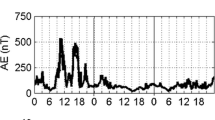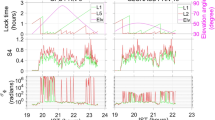Abstract
When plasma instabilities arise in the post-sunset time, the so-called ionospheric plasma bubbles may develop, causing amplitude fades and phase oscillations, decreasing the availability and quality of transionospheric communication systems. In the regions where these bubbles appear, deep signal fading may occasionally reach the lowest levels and with loss of signal received for a certain period. In this work, a characterization of deep power fades is performed supported by a dataset covering 5 months of high-rate monitoring data collected at four different locations in Brazil in distinct S4 scenarios for the three available frequencies. Two aspects of the deep fading events were evaluated, the deepest fading attained per minute and the fading events deeper than −15 dB. The inter-frequency analysis showed that as S4 increases, the number of −15 dB fading occurrences increases for all bands and stations. The average number of occurrences reached approximately 7 and 9 cases per minute, respectively, for Presidente Prudente and São José dos Campos. Statistical analysis for fading events deeper than −15 dB obtained probabilities of 1.61%, 2.87% and 3.97%, respectively, for L1, L2C and L5 at Presidente Prudente. Regarding the value of the deepest fading event per minute, the larger difference between L1, L2C and L5 exhibits values around −11 dB at Presidente Prudente. For this station, the average deepest fading values achieved in L2C and L5 bands were nearly twice that of the L1. The results regarding the probability of a deepest fading less than −20 dB per minute for L5 signal present a probability of 1.38% in Fortaleza, while for Presidente Prudente and São José dos Campos, these values were 5.62% and 3.34%.









Similar content being viewed by others
Data availability
The raw data used in this paper may be available to be downloaded by request through the CIGALA/CALIBRA website: http://is-cigala-calibra.fct.unesp.br/is/index.php
References
Abdu MA (2016) Electrodynamics of ionospheric weather over low latitudes. Geosci Lett 3:11. https://doi.org/10.1186/s40562-016-0043-6
Biswas T, Ghosh S, Paul A, Sarkar S (2019) Interfrequency performance characterizations of GPS during signal outages from an anomaly crest location. Space Weather 17(6):803–815
Carrano CS, Groves KM, McNeil WJ, Doherty PH (2012) Scintillation characteristics across the GPS frequency band. In: Proceedings of the 25th International Technical Meeting of The Satellite Division of the Institute of Navigation (ION GNSS 2012), pp 1972–1989
de Paula ER, Martinon AF, Moraes AO, Carrano C (2021) Performance of 6 different GNSS receivers at low latitude under moderate and strong scintillation. Earth Space Sci. https://doi.org/10.1029/2020EA001314
Delay SH, Carrano CS, Groves KM, Doherty PH (2015) KEYNOTE-A Statistical Analysis of GPS L1, L2, and L5 Tracking Performance During Ionospheric Scintillation. In: Proceedings of the ION 2015 Pacific PNT Meeting, pp 1–9
Fremouw EJ, Leadabrand RL, Livingston RC, Cousins MD, Rino CL, Fair BC, Long RA (1978) Early results from the DNA Wideband satellite experiment—complex-signal scintillation. Radio Sci 13(1):167–187
Goswami S, Paul KS, Paul A (2017) Assessment of GPS multi-frequency signal characteristics during periods of ionospheric scintillations from an anomaly crest location. Radio Sci 52(9):1214–1222
Guo K, Aquino M, Veettil SV (2019) Ionospheric scintillation intensity fading characteristics and GPS receiver tracking performance at low latitudes. GPS Solut 23(2):43
Hlubek N, Berdermann J, Wilken V, Gewies S, Jakowski N, Wassaie M, Damtie B (2014) Scintillations of the GPS, GLONASS, and Galileo signals at equatorial latitude. J Space Weather Space Clim 4:A22
Jiao Y, Morton YT, Akos D, Walter T (2015) A comparative study of triple frequency GPS scintillation signal amplitude fading characteristics at low latitudes. In: Proceedings of the 28th International Technical Meeting of The Satellite Division of the Institute of Navigation (ION GNSS+ 2015). pp 3819–3825
Jiao Y, Xu D, Morton Y, Rino C (2016) Equatorial scintillation amplitude fading characteristics across the GPS frequency bands. Navigation 63(3):267–281
Moraes AO, Costa E, Abdu MA, Rodrigues FS, de Paula ER (2017) The variability of low-latitude ionospheric amplitude and phase scintillation detected by a triple-frequency GPS receiver. Radio Sci 52(4):439–460
Moraes ADO, Vani BC, Costa E, Abdu MA (2018a) GPS availability and positioning issues when the signal paths are aligned with ionospheric plasma bubbles. GPS Solut 22(4):95. https://doi.org/10.1007/s10291-018-0760-8
Moraes ADO, Vani BC, Costa E, Sousasantos J, Abdu MA, Rodrigues F, Monico JFG (2018b) Ionospheric scintillation fading coefficients for the GPS L1, L2, and L5 frequencies. Radio Sci 53(9):1165–1174
Oliveira CB, Espejo TM, Moraes A, Costa E, Sousasantos J (2020) Analysis of plasma bubble signatures in total electron content maps of the low-latitude ionosphere: a simplified methodology. Surv Geophys 41:897–931. https://doi.org/10.1007/s10712-020-09584-7
Portella IP, de Moraes A, da Silva Pinho M, de Sousasantos J, Rodrigues F (2021) Examining the tolerance of GNSS receiver phase tracking loop under the effects of severe ionospheric scintillation conditions based on its bandwidth. Radio Sci. https://doi.org/10.1029/2020RS007160
Salles LA. Vani BC, Moraes A, Costa E, de Paula ER (2021) Investigating Ionospheric Scintillation Effects on Multifrequency GPS Signals. Surveys in Geophysics. https://doi.org/10.1007/s10712-021-09643-7
Seo J, Walter T, Chiou TY, Enge P (2009) Characteristics of deep GPS signal fading due to ionospheric scintillation for aviation receiver design. Radio Sci 44(01):1–10
Seo J, Walter T, Enge P (2011) Correlation of GPS signal fades due to ionospheric scintillation for aviation applications. Adv Space Res 47(10):1777–1788
Sharma AK, Gurav OB, Gaikwad HP, Chavan GA, Nade DP, Nikte SS (2018) Study of equatorial plasma bubbles using all sky imager and scintillation technique from Kolhapur station: a case study. Astrophys Space Sci 363(4):83
Sousasantos J, Oliveira Moraes AD, Sobral JH, Muella MT, Paula ERD, Paolini RS (2018) Climatology of the scintillation onset over southern Brazil. Ann Geophys 36:565–576
Vani BC, Forte B, Monico JFG, Skone S, Shimabukuro MH, Moraes AO (2019) A novel approach to improve GNSS Precise Point Positioning during strong ionospheric scintillation: theory and demonstration. IEEE Trans Veh Technol 68(5):4391–4403. https://doi.org/10.1109/TVT.2019.2903988
Yasyukevich YV, Yasyukevich AS, Astafyeva EI (2021) How modernized and strengthened GPS signals enhance the system performance during solar radio bursts. GPS Solut 25(2):1–12
Acknowledgements
LAS thanks CAPES (88887.137186/2017-00/0). AOM is supported by CNPq (314043/2018-7). J. Sousasantos acknowledges FAPESP for support under process 2018/06158-9. JFGM is grateful to CNPq and FAPESP under awards (INCT GNSS-NavAer) 465648/2014-2 and 2017/50115-0, respectively. Currently, data access is provided by INCT GNSS-NavAer. The authors are grateful to Estudo e Monitoramento Brasileiro do Clima Espacial (EMBRACE) for providing CCD all-sky data used in the illustration of Figure 1 (http://www2.inpe.br/climaespacial/portal/en/). We acknowledge the Instituto Brasileiro de Geografia e Estatística (IBGE) for maintaining Rede Brasileira de Monitoramento Contínuo (RBMC) where GPS RINEX files were accessed for the construction of TEC map of Figure 1.
Author information
Authors and Affiliations
Corresponding author
Additional information
Publisher's Note
Springer Nature remains neutral with regard to jurisdictional claims in published maps and institutional affiliations.
Rights and permissions
About this article
Cite this article
Salles, L.A., Moraes, A., Vani, B. et al. A deep fading assessment of the modernized L2C and L5 signals for low-latitude regions. GPS Solut 25, 122 (2021). https://doi.org/10.1007/s10291-021-01157-4
Received:
Accepted:
Published:
DOI: https://doi.org/10.1007/s10291-021-01157-4




